How to Read Content Labels on Herbicide
The pesticide label is your best guide to using pesticides safely and effectively. The directions on the characterization are in that location primarily to help you achieve maximum benefits – the pest control that you desire – with minimum take chances. Both depend on following label directions and correctly using the pesticide. Read the label before buying the pesticide. Follow the label each time you mix and use the pesticide, and follow the label when storing or disposing of the pesticide. Do not trust your memory. You may have forgotten part of the label instructions, or they may take changed since the terminal fourth dimension you purchased the production. Use of any pesticide in whatever manner that does not comply with label directions and precautions is illegal. It may besides be ineffective on the pests and, fifty-fifty worse, pose risks to users or the environment.
The main sections of a pesticide label are described below:
Brand Proper noun
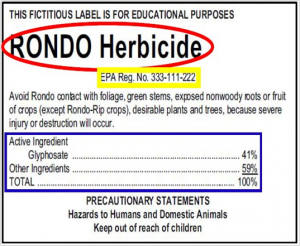 The brand or trade name is the name on the front console of the label that y'all commonly utilize to identify the product, such as Roundup or Sevin. Products with the same active ingredient may take completely different brand names depending on the manufacturer or company that registers the pesticide with the Environmental Protection Agency (EPA). Likewise, very similar brand names (whether used by the aforementioned or different companies) may comprise dissimilar active ingredients .
The brand or trade name is the name on the front console of the label that y'all commonly utilize to identify the product, such as Roundup or Sevin. Products with the same active ingredient may take completely different brand names depending on the manufacturer or company that registers the pesticide with the Environmental Protection Agency (EPA). Likewise, very similar brand names (whether used by the aforementioned or different companies) may comprise dissimilar active ingredients .
EPA Registration Number
This number tells you that EPA has reviewed the product and adamant that information technology can be used with minimal or depression hazard if yous follow the directions on the label properly .
Ingredients Statement
Active ingredients are the chemicals in the pesticide that kill or control the target pest(s). Inert ingredients oft ameliorate the effectiveness or prophylactic of a pesticide. This section provides the chemical name of each active ingredient, the percentage by weight of each agile ingredient, and the percentage by weight of all inert ingredients. Inert ingredients are not listed individually nor identified by proper noun.
Indicate Words
The signal words – Caution, Warning, or Danger – indicate the astute toxicity of the product to humans, based on ane or more potential routes of exposure. The statement "keep out of achieve of children" must also appear with signal words on the label of all pesticides.
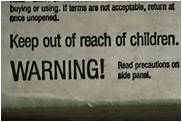 Caution — Pesticides that are the least harmful to y'all
Caution — Pesticides that are the least harmful to y'all
Alert — More than toxic than those with a Caution label
DANGER — Very poisonous or irritating and should be used with farthermost intendance because they tin severely fire your skin and eyes. Virtually pesticides with DANGER indicate give-and-take are restricted-use pesticides and are non available to the general public
Precautionary Statements
This part describes the protective clothing, such as gloves or goggles that y'all should vesture when using the pesticide. The department also tells you how to protect children or pets past keeping them away from areas treated with pesticides.
First Aid Instructions (Argument of Practical Treatment)
The label tells you lot what to do if someone is accidentally poisoned past the pesticide. These instructions are only commencement aid. E'er call the emergency number listed on the label, a physician, or the poison middle (ane-800-222-1222), if someone is accidentally poisoned past the pesticide. You lot may have to take the person to a hospital right away afterwards giving offset aid. Remember to take the pesticide characterization or container with you.
Personal Protective Equipment (PPE)
The label lists PPE needed to prevent exposure to the pesticide. Be sure to read this section earlier purchasing the pesticide.
Agricultural Use Requirements (Employ of pesticides in producing agronomical plants)
The "Agricultural Use Requirements" box printed on the label of pesticides refers to the requirements of the Worker Protection Standard (WPS) that must be complied within the production of an agronomical constitute (ingather) on an agricultural establishment. Come across the Worker Protection Standard section on this website for more data.
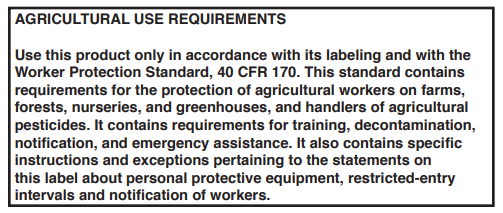
Ecology Hazards
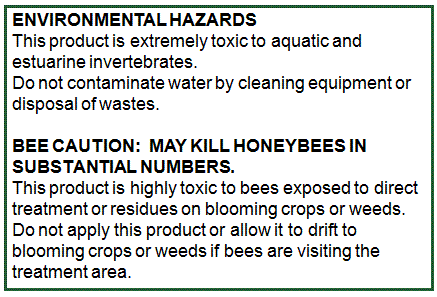 This section indicates if the product can cause environmental impairment – if it's harmful to wildlife, fish, pollinators, endangered plants or animals, or h2o bodies such as ponds, lakes, rivers, and wetlands.
This section indicates if the product can cause environmental impairment – if it's harmful to wildlife, fish, pollinators, endangered plants or animals, or h2o bodies such as ponds, lakes, rivers, and wetlands.
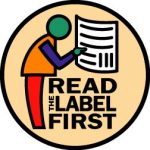
Directions for Use. Make certain that the production is labeled for utilize confronting the pest(s) that you are trying to control. (For instance, products labeled only for termites cannot be used to control fleas.) Use only the amounts indicated, and follow the directions exactly.
Note: It is a violation of Federal police force to use a production in any manner inconsistent with its labeling.
Storage and Disposal
Storage and Disposal. Read carefully and follow all directions for safe storage and disposal of pesticide products. Always keep products in the original container and out of reach of children—shop pesticides in a locked cabinet or locked garden shed. Disposal of pesticide containers in a fashion not listed past the label could lead to contamination of the environs or harm to other people. For more data, see the Storing Pesticides and Pesticide and Container Disposal sections of this website.
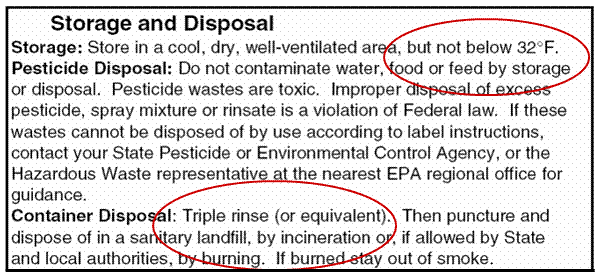
Other parts of the label provide additional important information about the use of the pesticide. Exist sure to read the entire label earlier each use of the pesticide.

For additional information on understanding a pesticide label:
- EPA: Continue Condom: Read the Characterization First
- What you need to know about: Reading a Pesticide Label. Penn State University.
Note – all labels used on this site are for educational purposes only. Any pesticide mentioned here is not for ad purposes.
Source: https://pesticidestewardship.org/homeowner/how-to-read-the-label/
Post a Comment for "How to Read Content Labels on Herbicide"